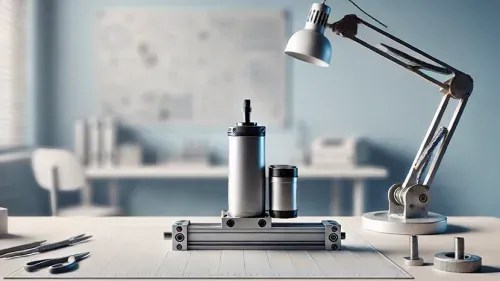Role Of Acrome Products in Prof. Claudia Yaşar’s Teaching Approach
Introduction:
Having hands-on experiments for engineering students alongside their theoretical courses is essential for the students to have a deep understanding of the main concepts and getting them ready for the work environment.
Prof. Claudia Fernanda Yaşar shares valuable insights about her teaching approach and talks about her criteria for choosing the products she gets for her experiments.
Who is Prof. Claudia Fernanda Yaşar ?
Dr. Fernanda Yaşar is an Assistant Professor in the Control and Automation Engineering Department at Yildiz Technical University. Her research interests include mechatronics, non-linear control systems, kinematic and dynamic control of rigid and flexible robots, servo motion systems, system identification, dynamics, modelling and simulation, force and torque sensors, active touch sensing for robots, process control, real-time control, intelligent control systems, and among others. Some of her recent projects include:
- Design, modeling, control, and vertical positioning of climbing robots under external effects (TUBITAK project)
- Studies on a robotic device that minimizes end-point vibrations for Parkinson’s tremor (3rd World Conference on Technology, Innovation and Entrepreneurship)

Importance of choosing the right teaching method:
Engineering programs often prioritize theory over practical applications, which can make it challenging for graduates to succeed in the workforce due to a lack of practical skills and experience. Additionally, engineering programs can be slow to adapt to new technologies, leaving students with outdated knowledge. Finally, there is often a disconnect between what students learn in the classroom and what they experience in the real world, making it difficult to apply theoretical knowledge. Professor Claudia Yaşar addresses these challenges by emphasizing practical implementation in her courses on control and automation engineering through homework assignments that require both simulation and real system implementation.
Prof. Claudia’s criteria for choosing the experiment products:
Prof. Claudia Yaşar follows a certain criteria before choosing suitable products for her students to use in her labs and courses. These criterias are:
Value for money:
Professor Claudia Yaşar has a set of criteria that she uses when choosing products for her labs and courses. One of these criteria is value for money, which is important because academic institutions often have limited funding. By selecting products that offer good value, teachers can ensure that they are getting the most for their money and that students have access to high-quality products that are up-to-date with the latest technology and tools. This can help students compete in the job market and prepare for life in the real world. Another important factor that Professor Yaşar considers is open-source software. By using products with open software, students have access to a variety of tools and resources, and products are updated regularly to ensure that students are learning with the newest resources and tools. This can help ensure that students are well-prepared for the job market and have the skills and knowledge they need to succeed.
Open-source software:
Another crucial criterion that Professor Claudia Yaşar considers when selecting products for her teaching approach is open-source software. Open software has a large community of developers supporting the product, which provides students with access to a variety of tools and resources. Additionally, open-source software ensures that the products are regularly updated and that students are taught using the latest resources and tools. By using products with open software, professors can help ensure that their students are well-prepared for the job market with the skills and knowledge required to succeed.

Ease to use:
Professor Claudia Yaşar values devices with user-friendly software and a Plug and Play design, as they allow students to focus on learning the topic rather than struggling with the technology. Simple and easy-to-use devices can also minimize frustration and increase engagement, ultimately helping students benefit more from their education. By selecting devices with these features, professors can ensure that their students can fully concentrate on the subject matter and get the most out of their learning experience.

Technical Support and Documentation:
Documentation and technical support are critical for engineering systems, as they provide the foundation for the system’s dependability, maintainability, and scalability. Proper documentation ensures that the system is well-documented and can be easily understood, while technical support helps users operate the system effectively. Without documentation and technical support, engineering systems can be difficult to use, maintain, and scale. Therefore, it is essential to have these two components to ensure that experimental systems can be used effectively and maintained properly.
Why Prof. Claudia chose Acrome’s products to be a part of her laboratory ?
Acrome products are suitable for students with limited experimental experience, as they come with extensive technical support in the form of guides and documentation. The engineering staff at Acrome is friendly, professional, and highly skilled, ensuring that users have access to top-notch support. The products are designed specifically for academic use, with user-friendly software and Plug and Play devices that are easy to use. They are also designed for real-time implementation, making them accessible to both teachers and students.
The courseware provided by Acrome offers a starting point for implementing and designing controllers without requiring extensive knowledge of mechanics or hard work. Some students even conduct research by implementing multiple control methods and applications, allowing them to evaluate performance and validate their findings.


You can check Prof. Claudia’s lab:
Conclusion:
To summarize, Professor Claudia Yaşar takes into account various factors when choosing products for her teaching approach. These factors include products that provide value for money, have open software, are easy to use, and are designed for academic settings. By selecting products that meet these criteria, professors can ensure that their students are well-prepared for their future careers and equipped with the necessary skills to succeed in the real world.
Check the full interview with Professor Claudia:















